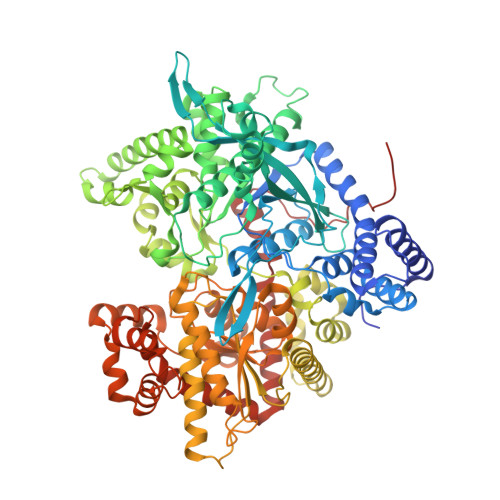Kinetic and crystallographic studies of glucopyranose spirohydantoin and glucopyranosylamine analogs inhibitors of glycogen phosphorylase.
Watson, K.A., Chrysina, E.D., Tsitsanou, K.E., Zographos, S.E., Archontis, G., Fleet, G.W., Oikonomakos, N.G.(2005) Proteins 61: 966-983
- PubMed: 16222658
- DOI: https://doi.org/10.1002/prot.20653
- Primary Citation of Related Structures:
1FS4, 1FTQ, 1FTW, 1FTY, 1FU4, 1FU7, 1FU8 - PubMed Abstract:
Glycogen phosphorylase (GP) is currently exploited as a target for inhibition of hepatic glycogenolysis under high glucose conditions. Spirohydantoin of glucopyranose and N-acetyl-beta-D-glucopyranosylamine have been identified as the most potent inhibitors of GP that bind at the catalytic site. Four spirohydantoin and three beta-D-glucopyranosylamine analogs have been designed, synthesized and tested for inhibition of GP in kinetic experiments. Depending on the functional group introduced, the K(i) values varied from 16.5 microM to 1200 microM. In order to rationalize the kinetic results, we determined the crystal structures of the analogs in complex with GP. All the inhibitors bound at the catalytic site of the enzyme, by making direct and water-mediated hydrogen bonds with the protein and by inducing minor movements of the side chains of Asp283 and Asn284, of the 280s loop that blocks access of the substrate glycogen to the catalytic site, and changes in the water structure in the vicinity of the site. The differences observed in the Ki values of the analogs can be interpreted in terms of variations in hydrogen bonding and van der Waals interactions, desolvation effects, ligand conformational entropy, and displacement of water molecules on ligand binding to the catalytic site.
Organizational Affiliation:
Laboratory of Molecular Biophysics, University of Oxford, Oxford, United Kingdom.
















